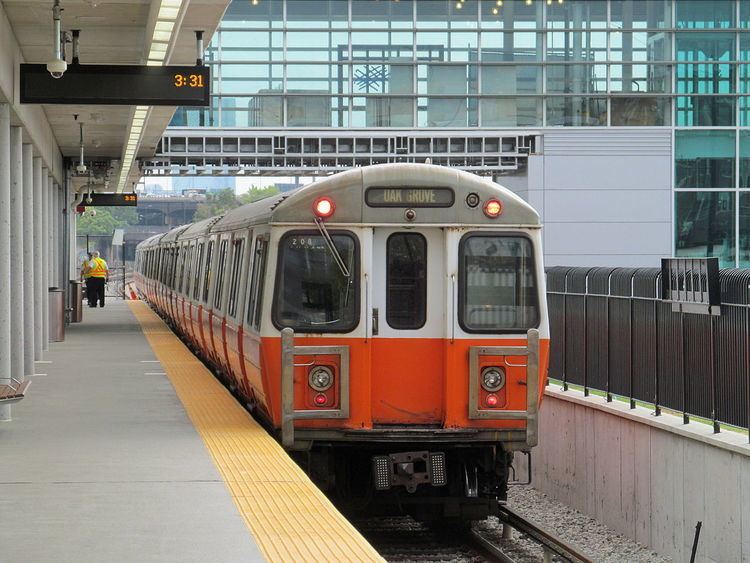Line(s) Orange Line Opened 2 September 2014 Platforms in use 1 | Bicycle facilities Racks provided Phone +1 617-222-3200 | |
 | ||
Location 499 Foley St, Somerville, Massachusetts Owned by Massachusetts Bay Transportation Authority Tracks 3 (two station tracks and one unused express track) Parking No MBTA parking; Assembly Square parking is adjacent Address 499 Foley St, Somerville, MA 02145, USA Owner Massachusetts Bay Transportation Authority Similar Sullivan Square, Wellington, Oak Grove, Haymarket, Community College | ||
Assembly (originally Assembly Square in some planning documents) is a rapid transit station on the MBTA's Orange Line, located in the eastern portion of Somerville, Massachusetts. It is an infill station, located on a section of the Orange Line that has been active since 1975. The station, which opened on September 2, 2014, was the first new station on the MBTA subway system since 1987.
Contents
Assembly station is meant to provide convenient access to Assembly Square - a major retail and residential development located on the site of a former Ford assembly plant - and the adjacent Assembly Square Marketplace. The Assembly Square project is estimated to generate 45,000 new vehicle trips each day, and the station was intended to reduce the number that use private automobiles by diverting travelers to mass transit. Ridership is projected to reach 5,000 riders per day in 2030; it averaged 1,864 during its first year.
Station layout
Assembly station is in the rear of the Assembly Square development, on the existing Orange Line tracks near the Mystic River.
The station consists of a single island platform 410 feet (120 m) long, to handle up to 6 railcars on each side. Unlike Community College, Sullivan, and Wellington, Assembly does not have a second island platform to serve the (currently unused) third track, which was intended to be an express track. The station has two headhouses, one on each end of the platform. Two footbridges, one from each headhouse, cross over the inbound track and connect to parking on G Street. The station is fully accessible and includes bicycle storage facilities.
Several public art elements are incorporated into the station. These include artistic benches and a metal panel mosaic on the station façade (both designed by Artists for Humanity) and MBTA-designed panels about the site's history.
Adding a commuter rail station at Assembly Square was listed as a possibility in 2012 as an interim air quality mitigation measure in response to delays building the Green Line Extension However, such a station could not be completed by 2015, and the project was not supported by MassDOT. The station would have required building separate platforms for the Haverhill Line and the Newburyport/Rockport Line, which split near the station site.
History and financing
Construction was estimated to cost up to $57 million, of which $22 million (plus an optional $3.5 million extra) was from the state's Executive Office of Housing and Economic Development. The remaining cost was divided between federal funding including the FTA Section 5309 New Starts program ($16 million) and the developer of Assembly Square ($15 million), Federal Realty Investment Trust (FRIT).
The area around the station formerly hosted a Ford automobile assembly plant, which used the adjacent Haverhill Line for rail access. Although the plant is long gone, the Assembly Square name is a reference to the site's history.
On February 8, 2011, the MBTA board unanimously approved a memorandum of understanding between the MBTA and FRIT, which defined the funding sources for the project. The memorandum was a "critical milestone," according to a FRIT executive. Somerville approved the project on May 2, 2011, and two days later the MBTA opened bidding for construction, which was planned to start at the end of 2011.
On October 5, 2011, the MBTA announced the award of a $29,229,184 construction contract to S&R Construction Co., Inc., with construction beginning later that fall. The work required 18 weekend closures of the Orange Line from Sullivan to Oak Grove. The first weekend closures began in June 2012 and continued past the station opening into late 2014. The closures were extended to five nights per week for the second half of 2012, and continued sporadically into 2013 and 2014.
For construction, the MBTA shifted outbound trains to the normally unused express track and inbound trains to the outbound track, to give construction crews full access to the site. In January 2013, the MBTA began constructing concrete pillars to support the platform and headhouses; elevator shaft construction began in the spring. Construction of the headhouse frames began in June 2013, and the platform segments were laid in July. The headhouses were completed in June 2014, with work remaining on other parts of the station.
Inbound trains switched back to the normal inbound track on July 1, 2014; outbound trains began using the normal outbound track on July 21. The station opened to passengers on September 2, 2014, although some final construction work lasted until November. On the first day of operations, the station platform flooded from a rainstorm.
Partners Healthcare, which is building its headquarters next to the south end of the station, is funding the completion of the south headhouse as a full-time entrance and exit. It will open in 2016.
Bus connections
Sullivan Square to the south and Wellington to the north are both major MBTA Bus terminals, so Assembly was not designed as a bus transfer station. No routes stop directly at the station; two routes run on Grand Union Boulevard 500 feet (150 m) to the west:
